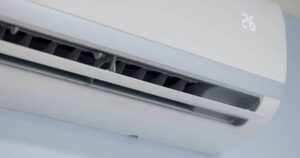Modern reverse cycle air conditioning utilises the heat trapped in the outside air and helps transfer it inside, warming your home on those cold winter nights. They also have energy-efficient inverter technology to help save on energy consumption.
A ducted system contains a fan-coil unit hidden within the roof. Ducts then branch off this unit to heat or cool individual rooms or zones. For more energy efficient reverse cycle ducted air conditioners, check this out.
Inverter technology
 Unlike conventional units with a switch-on/off operation, reverse cycle air conditioners with inverter technology use less energy to heat or cool your home. This is because they operate at a lower speed. This reduces power consumption and results in a higher level of comfort.
Unlike conventional units with a switch-on/off operation, reverse cycle air conditioners with inverter technology use less energy to heat or cool your home. This is because they operate at a lower speed. This reduces power consumption and results in a higher level of comfort.
Inverter technology also allows your AC to reach the desired temperature faster and maintain it with minimal fluctuations. This helps to minimise energy usage, which can save you money in the long run.
The size of your reverse cycle air conditioning system will directly impact its efficiency and capacity. Ensure that you have a specialist conduct an onsite load assessment and calculation to determine the ideal capacity for your home. An air conditioner that is too large for your home will consume excessive energy, while an undersized unit will struggle to keep up with heating and cooling needs.
Two reverse-cycle air conditioning systems exist, wall or window-mounted and ducted (whole of the house). Ducted systems require a more extensive outdoor compressor and ducting that distributes heat to multiple rooms in your home. For more energy efficient reverse cycle ducted air conditioners, check this out.
Air-purifying filters
The air in your home can contain dangerous microbes that cause illness. The quality filters used in reverse cycle ducted air conditioners can remove them and help to keep your family healthy.
Energy efficiency is another benefit of a ducted system. They produce 3 kW of heating and cooling for every 1 kW of electricity consumed, which means you can save on your power bills.
Unlike fans and evaporative coolers, which simply push the hot air around your home, an air conditioning system can remove humidity to create relaxed and comfortable conditions all year round.
A ducted reverse cycle system is the best option regarding energy efficiency. Ducted systems are efficient in their operation, producing less greenhouse gasses than heaters and using up to a third of the power required by traditional electric systems. At Rite Price, we stock various ducted reverse cycle models from leading manufacturers, including Mitsubishi Electric and Toshiba.
Zoning capabilities
Unlike evaporative coolers that simply push warm air around or fans that cool but don’t remove humidity, ducted reverse cycle systems do both and are, therefore, a true all-rounder.
Zoning capabilities are a bonus feature with ducted reverse cycle air conditioners and allow you to heat and cool individual rooms or zones of your home according to your needs. By ensuring your system only works when you need it, you can minimise energy usage and reduce your power bills. For more energy efficient reverse cycle ducted air conditioners, check this out.
Speak to your licenced professional dealer to find out how you can make the most of the zoning capabilities of a ducted reverse-cycle air conditioner. They will be able to provide you with a customised solution based on your unique heating and cooling requirements. This is a valuable service that may even help you increase the value of your home. Energy-efficient ducted systems also contribute to a greener future as they consume less electricity, reducing greenhouse gas emissions.
Energy efficiency
Unlike gas systems, reverse-cycle ducted air conditioners use electricity to heat and cool your home. However, they are known for their low energy usage and environmental impact. These systems utilise heat pump technology to extract and amplify the available heat energy in the surrounding air rather than directly generating it.
This process involves refrigerant absorbing heat from the outdoor air, which is then compressed in an indoor unit to release warm air. Compared to traditional electric heating, this allows ducted air conditioning to achieve well above 100% energy efficiency.